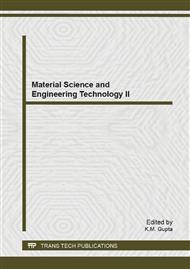p.285
p.290
p.294
p.299
p.304
p.309
p.314
p.321
p.327
Effect of Capping Agent on Physicochemical Properties of Zinc Substituted Nanoscale Hydroxyapatite
Abstract:
Nanoscale zinc substituted hydroxyapatite has been synthesized by solgel technique at 70 C using an aqueous solution of calcium nitrate tetrahydrate (CNT), zinc nitrate tetrahydrate (ZNT) and potassium dihydrogen phosphate (KDP) as starting materials with or without a capping agent, triethanolamine (TEA). The synthesized nanopowders were calcined at two temperatures 800 C and 1000 C for 1 hr. The morphology and size of nanopowders were characterized by transmission electron microscopy. The BET surface area was evaluated from N2 adsorption isotherms. Structural analysis and thermal behavior were investigated by means of Fourier transform infrared spectroscopy, x-ray diffraction and thermogravimetry. The results of TEM confirmed that TEA is effective in reducing average crystallite size from 15 nm in case of zinc substituted hydroxyapatite without TEA (ZnHA) to 9 nm in case of zinc substituted hydroxyapatite with TEA (ZnHA-TEA). FTIR spectra showed the presence of weaker HPO4 bands and stronger O-H bands in case of ZnHA as compared to ZnHA-TEA, which indicated that the formation of the latter is delayed due to TEA assistance. TGA study revealed that ZnHA is thermally more stable as compared to ZnHA-TEA. These results show that the introduction of capping agent effectively restricts the particle growth during precipitation as well as on calcination.
Info:
Periodical:
Pages:
304-308
Citation:
Online since:
December 2013
Authors:
Keywords:
Price:
Сopyright:
© 2014 Trans Tech Publications Ltd. All Rights Reserved
Share:
Citation:


